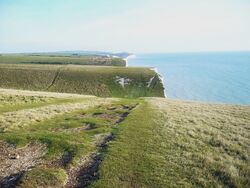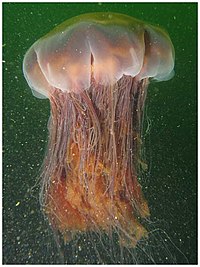
A coastal view of Sussex where "The Adventure of the Lion's Mane" takes place.
"The Adventure of the Lion's Mane" is a Sherlock Holmes short story by the British author Sir Arthur Conan Doyle. It was first published in the November 27, 1926, issue of the Liberty magazine in the United States and in the December 1926 issue of the Strand Magazine in England. The story was later collected in The Casebook of Sherlock Holmes (1927). "The Adventure of the Lion's Mane" is the fifty-third of fifty-six short stories of the Sherlock Holmes Canon. Doyle himself considered it one of the best among his later Sherlock Holmes tales.[1]
The story takes place in Sussex. Sherlock Holmes, now retired, lives in a small villa near the beach. One morning, a local school teacher is found near his favorite bathing spot with horrific wounds all over his bare back. He shrieks out with his dying breath the mysterious words "the Lion’s Mane." Suspicion soon falls on a fellow teacher. Holmes, however, has a nagging feeling that there is something among his vast collection of out-of-the-way knowledge that would help solve the case.
"The Adventure of the Lion's Mane" has the distinction of being the only story in the Sherlock Holmes Canon to describe Holmes' life in retirement. It is also one of the most unusual tales of the series. The story is narrated by Holmes himself[2] and does not feature Dr. Watson at all. Holmes also appears to express some uncharacteristic feelings. In addition, it is Holmes' knowledge rather than his reasoning ability which provides the solution to the mystery.
The story has been adapted for the radio many times. The first adaptation starring Richard Gordon was broadcast by NBC in the United States in March 1931. In the 1995 dramatization, an episode of The BBC Presents: Sherlock Holmes series starring Clive Merrison, Holmes recounts the events to Watson during a weekend visit.
Plot[]
Sherlock Holmes is now retired and lives in a small lonely villa on the coast of Sussex. Half a mile from the villa is a school called The Gables, and Holmes has become good friends with its headmaster, Harold Stackhurst.
One beautiful morning, Holmes is out taking a stroll down the cliff path to the beach when Stackhurst joins him. Stackhurst says he is going for a swim and expects to find Fitzroy McPherson, the science master, already there. At that moment, McPherson appears from the end of the path, staggering badly. Then, with a horrible cry, he falls face-down. Holmes and Stackhurst rush to his side and turn him over. McPherson utters a few slurred words, then shrieks out with his dying breath a phrase which sounds like "the Lion's Mane."
McPherson is dressed only in his overcoat, trousers, and an unlaced pair of canvas shoes. The overcoat slipped off when he fell, exposing his torso. His back is covered with dark red lines as if he had been flogged. It must have been terribly painful, for his face is distorted and his lower lip is bitten through.
As Holmes examines the body, Ian Murdoch, the mathematics tutor, approaches. Murdoch is known to be an aloof man with a ferocious temper, and Holmes has heard that he and McPherson were not on good terms. However, Murdoch appears to be thoroughly shocked at what he sees. In answer to Holmes' question, he states that he has just come from The Gables and has not been on the beach yet. Holmes sends Murdoch to the police station then, leaving Stackhurst to guard the body, goes down the path to examine the area.
He finds no one on the beach close enough to have committed the crime. There are no tracks in the area other than those made by McPherson on coming and going. There is a lagoon at the bottom of the path, and McPherson's unused towel, folded and dry, is found on the rock to the side. There are both shoe prints and bare foot prints. Holmes concludes that McPherson was ready to bathe but had not yet done so when he was attacked.
By the time Holmes returns to the body, Murdoch is back with Anderson, the village constable. Holmes instructs Anderson to send for his superior and a doctor. He then searches McPherson's pockets and finds a note written in a feminine hand: "I will be there, you may be sure" signed "Maudie." Finding nothing else of interest, Holmes walks back to his villa for breakfast.
Stackhurst comes by in an hour or two with some news. The body has been moved to The Gables. Stackhurst has found in McPherson's desk several intimate correspondences with a Maud Bellamy. He has also discovered that McPherson was alone on the beach because the students, who would otherwise have been with him, were held back by Murdoch for some algebraic demonstration. Stackhurst says Murdoch is terribly upset about it. At one time, Murdoch and McPherson were at odds over Murdoch's mistreatment of McPherson's dog. But they had reconciled and had been good friends for the past year.
Maud Bellamy is the daughter of Tom Bellamy who owns all the boats and bathing cots in the nearby village of Fulworth. According to Stackhurst, Maud is a well-known beauty with many admirers. Holmes suggests they walk to Fulworth to begin their investigation.
As they approach the Bellamys' residence, they see Ian Murdoch come out of the garden gate. Stackhurst confronts him and asks what he is doing there. Murdoch takes offense at the inquiry into his private actions, and they quarrel. Stackhurst, under the strain of the day, loses his temper and fires Murdoch. Murdoch barks back that he had already meant to leave, having lost the only friend he had at The Gables. As Murdoch storms off, suspicion begins to form in Holmes' mind.
Holmes and Stackhurst proceed to the house. Mr. Bellamy is not pleased to see them. He and his son had disapproved of McPherson's attentions on Maud. As they talk, Maud Bellamy appears. Holmes is struck by her beauty. She has already heard the news from Murdoch. Going against her father's and brother's wishes, she asks for the particulars and also offers to help with the investigation. Holmes is impressed by the strength of her character.
Holmes asks Maud about the note found in McPherson's pocket. She reveals that she and McPherson were secretly engaged to be married. They had kept it a secret because McPherson's elderly uncle might have disinherited him, and also because her father had been against the match. She produces a letter from McPherson, in reply to which she had written the note in question. She was to have met him this evening. Holmes notices that McPherson's letter did not come by post, but Maud refuses to say how she got it. She does not know of any enemies her fiancé had. She admits, however, to having had several admirers, including Ian Murdoch.
A week later, with no new evidence uncovered, Holmes is at a loss when his housekeeper mentions McPherson's dog. The dog had been grieving for its master and refusing to eat, and finally it was found dead at the very place McPherson died. Holmes goes to The Gables to interview the students who found the dog. They say that the dog was lying on the edge of the pool. Holmes then looks at the dead dog. The body is contorted, suggesting the dog died in agony just like its master.
Holmes goes back to the bathing pool and stands in deep meditation. He has a nagging feeling that there is some important fact he knows but cannot quite remember. Then, just as he begins to leave the scene, it suddenly comes to him. He returns home and searches through his books. It is late when he finds the volume he was looking for, and Holmes retires for the night.
In the early morning, before Holmes can pursue his idea, Inspector Bardle comes by for an unofficial consultation. He wants to know if he should arrest Murdoch before he leaves The Gables. Holmes reminds the inspector that Murdoch was with students at the time of McPherson's death. It is also unlikely that he could have attacked McPherson single-handedly. Holmes then brings out an enlarged photograph of McPherson's wounds. He points out peculiar and uneven patterns left by the weapon. The marks could have been made by a very stiff cat-o'-nine-tails with small hard knots on it. Holmes also brings to the inspector's attention McPherson's last words, "the Lion's Mane."
Suddenly, the door opens and Murdoch staggers in, followed by Stackhurst. Murdoch falls on the sofa and cries for something to ease the pain. His shoulder is marked with the same strange pattern of inflamed red lines they saw on McPherson's back. The terrible pain also seems to affect his breathing and his heart. They pour brandy down his throat and apply oil on the wounds until Murdoch finally falls into an exhausted sleep.
Stackhurst tells Holmes that he found Murdoch reeling in pain at the edge of the pool. Holmes leads Stackhurst and the inspector to the lagoon. They walk along the edge of the water to the perfect bathing spot under the cliff where the water is deep and still. Peering into the water, Holmes finds what he was searching for. He points to something on a rocky shelf three feet under water and cries out "Cyanea! Behold the Lion’s Mane!" It is a hairy pulsating creature with streaks of silver among its yellow tresses. With Stackhurst's help, Holmes pushes a large boulder into the water, crushing the creature.

Lion's mane jellyfish.
The party returns to the villa and finds Murdoch feeling better and sitting up. Holmes brings out his book in which the author recounts a near-fatal encounter with Cyanea Capillata, the Lion's Mane Jellyfish. There is no doubt that McPherson died as a result of his encounter with the creature.
Murdoch, now cleared of suspicion, offers some explanations. He had loved Maud Bellamy. Once she chose his friend, he decided to act as their go-between to help her to happiness. When McPherson was killed, he rushed over to see Maud to break the news gently. Stackhurst offers his hand to Murdoch in a gesture of reconciliation.
After Stackhurst and Murdoch leave arm in arm, Inspector Bardle voices his admiration for Holmes. Holmes, however, regrets his slowness. He had been misled by McPherson's dry towel. He thought McPherson had not been in the water so the thought of a water creature did not occur to him.
Footnotes[]
- ↑ In 1927, the Strand Magazine held a readers' contest to select the best Sherlock Holmes short stories. They also asked Sir Arthur Conan Doyle to compile his own list of favorites. Doyle excluded the latest, uncollected stories from official consideration (The Casebook of Sherlock Holmes had not yet been published), but he stated that he would have included "The Adventure of the Lion's Mane" and "The Adventure of the Illustrious Client" in the list if they had been available. Although Doyle felt "The Adventure of the Lion's Mane" was "hampered by being told by Holmes himself," he believed its plot to be "among the very best of the whole series."
- ↑ The only other story in the Sherlock Holmes Canon presented as having been written by Holmes himself is "The Adventure of the Blanched Soldier."
